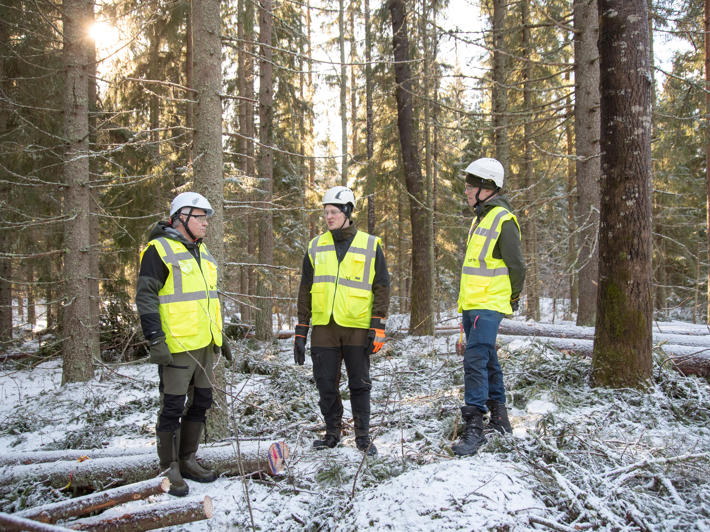Herb-rich forests are an important habitat for numerous threatened forest species. However, the species in old herb-rich forests especially depend on broadleaved trees and may suffer from the strong growth of spruce trees. In such cases, the herb-rich forest habitat should be managed with nature management-based felling operations.
In March 2023, a felling operation was performed in forest owner Jyrki Viukari’s herb-rich forest in Pälkäne as a nature management measure.
“My forest estate includes a herb-rich forest of about 1.6 hectares, the Evinsalo small-leaved lime forest, which became protected in the early 2000s. The Finnish Forest Centre drew up a forest management plan for the forest, which was then approved by the ELY Centre,” says Viukari.
Viukari had previously concluded a wood trade elsewhere on his estate. The felling operations were about to begin when Viukari received a phone call. The caller was Jukka Ruutiainen, a nature management specialist from the Finnish Forest Centre, and he asked if it would be possible to carry out nature management activities during the felling operations.
“I told him that it was fine by me.“
Spruce trees individually marked
After the phone call, things moved fast. Ruutiainen contacted Metsä Group’s forest specialist Herman Walkeajärvi, and two days later, Walkeajärvi, Ruutiainen and Viukari met for a forest visit.
“At the same time, we concluded a wood trade with the forest owner regarding the spruce trees to be removed from the herb-rich forest,” says Walkeajärvi.
Ruutiainen, the specialist from the Finnish Forest Centre, marked the spruce trees to be removed and planned the network of routes for the forest machinery. Written instructions were drafted for the harvester operator in cooperation with Metsä Group. They instructed the operator to remove spruce trees from near small-leaved lime trees, as they interfere with the lime trees’ growth.
“Herb-rich forests are special sites. Marking the trees to be removed with ribbons makes the operator’s work easier, as they won’t need to make the selection themselves,” says Walkeajärvi.
Herb-rich forests are managed in the winter
Herb-rich forests only comprise about one per cent of all forests in Finland, but their importance is much greater than their area would suggest when you measure their biodiversity and the number of threatened species. According to estimates, nearly half of threatened forest species live in herb-rich forests.
The layered habitat and plentiful nutrition attract birds to herb-rich forests, and there are significantly more nesting birds in herb-rich forests than in heath forests.
“The felling in the Evinsalo small-leaved lime forest was carried out in the winter so that the work would not disrupt the birds’ nesting season. In the winter, the ground is also frozen, which helps avoid the risk of depressions in the forest floor,” says Walkeajärvi.
The conditions in March were excellent for nature management felling in the Evinsalo small-leaved lime forest.
“The felling happened to take place during the best weather of the whole winter,” says Walkeajärvi.
Nature management recommended
In the past, herb-rich forests were cleared to make way for fields because of their nutrient-rich soil. The most representative of the remaining forests have been protected under the conservation programme for herb-rich forests. Many herb-rich forests in commercial forests can be voluntarily protected through the METSO programme, either permanently or for a fixed period. The forest owner is paid compensation for the protection.
Metsä Group primarily recommends nature management for the herb-rich forests in the commercial forests of its owner-members, which means emphasising management measures that improve biodiversity instead of tree growth. The forest owner always decides which method to use.
The Finnish Forest Centre’s specialist Ruutiainen serves as the project manager in the Lehtokeskusalueiden luontohelmet project, which supports nature management measures for herb-rich forests. The project provides assistance for the planning, instructions and implementation of nature management measures for herb-rich forests. If additional costs are incurred for the management operations, the persons carrying out the work are compensated.
In general, it is best to combine the nature management operations in herb-rich forests with felling operations in nearby commercial forests, so that the forest owner’s financial targets and natural biodiversity can both be taken into account. The nature management felling operations in the Evinsalo small-leaved lime forest were a textbook example.
Flexible cooperation
The forest owner received the market price for the spruce trees removed during the nature management felling operations in the Evinsalo small-leaved lime forest, and the trees will be industrially utilised.
The forest owner was very happy about the finished project.
“The project was excellent. Fast and efficient in every way.”
Thanks to skilful planning and an expert operator, the natural landscape was also almost entirely undisturbed.
“There were no radical changes: the forest just became a little less dense.”
Walkeajärvi and Ruutiainen were also satisfied with the outcome. The cooperation worked smoothly, and the results were faultless.
“The work was carried out very well, and the small-leaved lime trees weren’t damaged by the felling. They will now have more light and room to grow,” says Ruutiainen.
“Communication with the Finnish Forest Centre was excellent, and the process proceeded flexibly.
Text Maria Latokartano
Photo Mika Ankkuri
This text was published in Metsä Group’s Viesti 2/2023.
